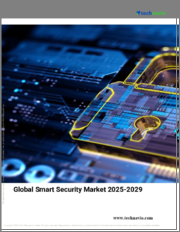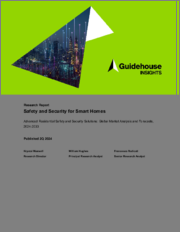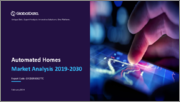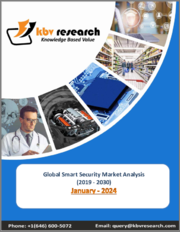
|
시장보고서
상품코드
1732051
세계의 스마트 보안 시장 조사 보고서 : 산업 분석, 규모, 점유율, 성장, 동향, 예측(2025-2033년)Global Smart Security Market Research Report- Industry Analysis, Size, Share, Growth, Trends and Forecast 2025 to 2033 |
||||||
스마트 보안 시장은 안전에 대한 관심이 높아짐에 따라 첨단 보안 솔루션에 대한 수요가 지속적으로 증가함에 따라 큰 폭의 성장을 이룰 것으로 전망됩니다. 스마트 보안 시스템은 IoT 기술, 인공지능, 데이터 분석을 활용하여 감시, 출입관리, 위협 감지 기능을 강화한 것입니다. 기업과 소비자가 안전과 보안을 우선시하는 가운데, 스마트 보안 솔루션의 도입이 급증하며 시장 확대의 원동력이 될 것으로 예상됩니다.
기술의 발전은 스마트 보안 시장에 큰 영향을 미치고 있으며, 혁신은 보안 시스템의 효과와 효율성 향상에 초점을 맞추고 있습니다. 스마트 카메라, 모션 센서, 경보 시스템의 통합으로 실시간 모니터링과 보안 위협에 대한 대응이 가능해졌습니다. 또한, 모바일 애플리케이션과 클라우드 기반 플랫폼의 개발로 보안 시스템에 대한 사용자의 접근성과 제어가 강화되어 원격 모니터링 및 관리가 가능해졌습니다. 이러한 기술이 계속 발전함에 따라 스마트 보안 솔루션의 기능이 강화될 뿐만 아니라 주거, 상업, 산업 등 다양한 분야로의 적용이 확대될 것입니다.
또한, 스마트 보안 시장은 증가하는 규제 요건과 안전 표준 준수에 대한 필요성이 증가함에 따라 수혜를 받고 있습니다. 조직이 보안 관행에 대한 감시가 강화됨에 따라 컴플라이언스를 보장하는 종합적인 스마트 보안 솔루션에 대한 수요가 증가할 것으로 예상됩니다. 이러한 추세는 기업들이 보안 프레임워크를 강화하고 무단 액세스 및 범죄 행위와 관련된 위험을 줄이기 위해 이 시장의 기술 혁신과 투자를 촉진할 것으로 보입니다. 기술 발전, 시장 수요, 규제 환경의 지원이 어우러져 스마트 보안 분야는 지속적인 성장을 이루며 전체 보안 상황에 큰 기여를 할 것으로 예상됩니다.
당사의 보고서는 고객에게 다양한 산업 및 시장에 대한 포괄적이고 실용적인 인사이트를 제공하기 위해 세심하게 작성되었습니다. 각 보고서에는 시장 상황을 완전히 이해하기 위한 몇 가지 중요한 요소가 포함되어 있습니다:
시장 개요 : 정의, 분류, 산업 현황 등 시장에 대한 자세한 소개.
시장 촉진요인 : 시장 성장에 영향을 미치는 주요 촉진요인, 억제요인, 시장 촉진요인 및 과제를 상세히 분석합니다. 이 섹션에서는 기술 발전, 규제 변화, 새로운 트렌드 등의 요인을 검토합니다.
세분화 분석 : 제품 유형, 용도, 최종사용자, 지역 등의 기준에 따라 시장을 명확한 부문으로 분류합니다. 이 분석을 통해 각 부문의 성과와 잠재력을 파악할 수 있습니다.
경쟁 환경 : 시장 점유율, 제품 포트폴리오, 전략적 이니셔티브, 재무 실적 등 주요 시장 플레이어에 대한 종합적인 평가. 주요 기업들이 채택하고 있는 경쟁 역학 및 주요 전략에 대한 인사이트를 제공합니다.
시장 예측 : 과거 데이터와 현재 시장 상황을 바탕으로 일정 기간 동안 시장 규모와 성장 추세를 예측합니다. 여기에는 정량적 분석과 향후 시장 궤적을 보여주는 그래프 표시가 포함됩니다.
지역 분석 : 지역별 시장 성과를 평가하고 주요 시장 및 지역 동향을 파악할 수 있습니다. 지역 시장 역학 및 비즈니스 기회를 이해하는 데 도움이 됩니다.
새로운 트렌드와 기회 : 현재 시장 동향과 새로운 시장 동향, 기술 혁신, 잠재적 투자 대상 분야를 파악합니다. 향후 시장 개척 및 성장 전망에 대한 인사이트를 제공합니다.
목차
제1장 서문
제2장 주요 요약
- 시장 하이라이트
- 세계 시장 현황
제3장 스마트 보안 산업 분석
- 소개 : 시장 역학
- 시장 성장 촉진요인
- 시장 성장 억제요인
- 시장 기회
- 업계 동향
- Five Forces 분석
- 시장 매력 분석
제4장 밸류체인 분석
- 밸류체인 분석
- 원재료 분석
- 원재료 리스트
- 원재료 제조업체 리스트
- 주요 원재료 가격 동향
- 잠재적 바이어 리스트
- 마케팅 채널
- 직접 마케팅
- 간접 마케팅
- 마케팅 채널 발전 동향
제5장 스마트 보안 세계 시장 분석 : 유형별
- 개요 : 유형별
- 실적과 예측 데이터 분석 : 유형별
- 스마트 침입자 알람
- 지능형 비디오 감시
- 입퇴실 관리 시스템
- 기타
제6장 스마트 보안 세계 시장 분석 : 프로토콜별
- 개요 : 프로토콜별
- 실적과 예측 데이터 분석 : 프로토콜별
- 무선 프로토콜
- 유선 프로토콜
- 하이브리드
제7장 스마트 보안 세계 시장 분석 : 용도별
- 개요 : 용도별
- 실적과 예측 데이터 분석 : 용도별
- 상업
- 주택
- 산업
제8장 스마트 보안 세계 시장 분석 : 지역별
- 지역별 전망
- 소개
- 북미의 매출 분석
- 개요, 실적과 예측
- 북미 : 부문별
- 북미 : 국가별
- 미국
- 캐나다
- 멕시코
- 유럽의 매출 분석
- 개요, 실적과 예측
- 유럽 : 부문별
- 유럽 : 국가별
- 영국
- 프랑스
- 독일
- 이탈리아
- 러시아
- 기타 유럽
- 아시아태평양의 매출 분석
- 개요, 실적과 예측
- 아시아태평양 : 부문별
- 아시아태평양 : 국가별
- 중국
- 인도
- 일본
- 한국
- 호주
- 동남아시아
- 기타 아시아태평양
- 라틴아메리카의 매출 분석
- 개요, 실적과 예측
- 라틴아메리카 : 부문별
- 라틴아메리카 : 국가별
- 브라질
- 아르헨티나
- 페루
- 칠레
- 기타 라틴아메리카
- 중동 및 아프리카의 매출 분석
- 개요, 실적과 예측
- 중동 및 아프리카 : 부문별
- 중동 및 아프리카 : 국가별
- 사우디아라비아
- 아랍에미리트
- 이스라엘
- 남아프리카공화국
- 기타 중동 및 아프리카
제9장 스마트 보안 기업 경쟁 구도
- 스마트 보안 시장 경쟁
- 제휴, 협력, 합의
- 인수합병
- 신제품 발매
- 기타 개발
제10장 기업 개요
- 상위 기업의 시장 점유율 분석
- 시장 집중도
- Alarm.Com.
- Netgear
- ADT
- Hangzhou Hikvision Digital Technology Co. Ltd.
- Honeywell International Inc.
- Johnson Controls.
- Samsung Electronics Co.
- Ltd
- Amazon.Com Inc.
- Robert Bosch GmbH
- Legrand
The smart security market is set to experience substantial growth as the demand for advanced security solutions continues to rise in response to increasing safety concerns. Smart security systems leverage IoT technology, artificial intelligence, and data analytics to provide enhanced surveillance, access control, and threat detection capabilities. As businesses and consumers prioritize safety and security, the adoption of smart security solutions is expected to surge, driving market expansion.
Technological advancements are significantly influencing the smart security market, with innovations focused on improving the effectiveness and efficiency of security systems. The integration of smart cameras, motion sensors, and alarm systems is enabling real-time monitoring and response to security threats. Additionally, the development of mobile applications and cloud-based platforms is enhancing user accessibility and control over security systems, allowing for remote monitoring and management. As these technologies continue to evolve, they will not only enhance the capabilities of smart security solutions but also expand their applications across various sectors, including residential, commercial, and industrial.
Furthermore, the smart security market is benefiting from increasing regulatory requirements and the need for compliance with safety standards. As organizations face growing scrutiny regarding their security practices, the demand for comprehensive smart security solutions that ensure compliance is expected to rise. This trend is likely to drive innovation and investment in the market, as companies seek to enhance their security frameworks and mitigate risks associated with unauthorized access and criminal activity. The convergence of technological advancements, market demand, and regulatory support positions the smart security sector for sustained growth and significant contributions to the overall security landscape.
Our reports are meticulously crafted to provide clients with comprehensive and actionable insights into various industries and markets. Each report encompasses several critical components to ensure a thorough understanding of the market landscape:
Market Overview: A detailed introduction to the market, including definitions, classifications, and an overview of the industry's current state.
Market Dynamics: In-depth analysis of key drivers, restraints, opportunities, and challenges influencing market growth. This section examines factors such as technological advancements, regulatory changes, and emerging trends.
Segmentation Analysis: Breakdown of the market into distinct segments based on criteria like product type, application, end-user, and geography. This analysis highlights the performance and potential of each segment.
Competitive Landscape: Comprehensive assessment of major market players, including their market share, product portfolio, strategic initiatives, and financial performance. This section provides insights into the competitive dynamics and key strategies adopted by leading companies.
Market Forecast: Projections of market size and growth trends over a specified period, based on historical data and current market conditions. This includes quantitative analyses and graphical representations to illustrate future market trajectories.
Regional Analysis: Evaluation of market performance across different geographical regions, identifying key markets and regional trends. This helps in understanding regional market dynamics and opportunities.
Emerging Trends and Opportunities: Identification of current and emerging market trends, technological innovations, and potential areas for investment. This section offers insights into future market developments and growth prospects.
SEGMENTATION COVERED IN THE REPORT
By Type
- Smart Intruder Alarms
- Intelligent Video Surveillance
- Access Control Systems
- Others
By Protocols
- Wireless Protocols
- Wired Protocols
- Hybrid
By Application
- Commercial
- Residential
- Industrial
- COMPANIES PROFILED
- Alarm.com.
- Netgear
- ADT
- Hangzhou Hikvision Digital Technology Co. Ltd.
- Honeywell International Inc.
- Johnson Controls.
- samsung electronics co.
- ltd
- Amazon.com Inc.
- Robert Bosch GmbH
- Legrand
- The above list can be customized.
TABLE OF CONTENTS
1. PREFACE
- 1.1. Report Description
- 1.1.1 Objective
- 1.1.2 Target Audience
- 1.1.3 Unique Selling Proposition (USP) & offerings
- 1.2. Research Scope
- 1.3. Research Methodology
- 1.3.1 Market Research Process
- 1.3.2 Market Research Methodology
2. EXECUTIVE SUMMARY
- 2.1. Highlights of Market
- 2.2. Global Market Snapshot
3. SMART SECURITY INDUSTRY ANALYSIS
- 3.1. Introduction - Market Dynamics
- 3.2. Market Drivers
- 3.3. Market Restraints
- 3.4. Opportunities
- 3.5. Industry Trends
- 3.6. Poerter's Five Force Analysis
- 3.7. Market Attractiveness Analysis
- 3.7.1 Market Attractiveness Analysis By Type
- 3.7.2 Market Attractiveness Analysis By Protocols
- 3.7.3 Market Attractiveness Analysis By Application
- 3.7.4 Market Attractiveness Analysis By Region
4. VALUE CHAIN ANALYSIS
- 4.1. Value Chain Analysis
- 4.2. Raw Material Analysis
- 4.2.1 List of Raw Materials
- 4.2.2 Raw Material Manufactures List
- 4.2.3 Price Trend of Key Raw Materials
- 4.3. List of Potential Buyers
- 4.4. Marketing Channel
- 4.4.1 Direct Marketing
- 4.4.2 Indirect Marketing
- 4.4.3 Marketing Channel Development Trend
5. GLOBAL SMART SECURITY MARKET ANALYSIS BY TYPE
- 5.1. Overview By Type
- 5.2. Historical and Forecast Data Analysis By Type
- 5.3. Smart Intruder Alarms Historic and Forecast Sales By Regions
- 5.4. Intelligent Video Surveillance Historic and Forecast Sales By Regions
- 5.5. Access Control Systems Historic and Forecast Sales By Regions
- 5.6. Others Historic and Forecast Sales By Regions
6. GLOBAL SMART SECURITY MARKET ANALYSIS BY PROTOCOLS
- 6.1. Overview By Protocols
- 6.2. Historical and Forecast Data Analysis By Protocols
- 6.3. Wireless Protocols Historic and Forecast Sales By Regions
- 6.4. Wired Protocols Historic and Forecast Sales By Regions
- 6.5. Hybrid Historic and Forecast Sales By Regions
7. GLOBAL SMART SECURITY MARKET ANALYSIS BY APPLICATION
- 7.1. Overview By Application
- 7.2. Historical and Forecast Data Analysis By Application
- 7.3. Commercial Historic and Forecast Sales By Regions
- 7.4. Residential Historic and Forecast Sales By Regions
- 7.5. Industrial Historic and Forecast Sales By Regions
8. GLOBAL SMART SECURITY MARKET ANALYSIS BY GEOGRAPHY
- 8.1. Regional Outlook
- 8.2. Introduction
- 8.3. North America Sales Analysis
- 8.3.1 Overview, Historic and Forecast Data Sales Analysis
- 8.3.2 North America By Segment Sales Analysis
- 8.3.3 North America By Country Sales Analysis
- 8.3.4 United States Sales Analysis
- 8.3.5 Canada Sales Analysis
- 8.3.6 Mexico Sales Analysis
- 8.4. Europe Sales Analysis
- 8.4.1 Overview, Historic and Forecast Data Sales Analysis
- 8.4.2 Europe By Segment Sales Analysis
- 8.4.3 Europe By Country Sales Analysis
- 8.4.4 United Kingdom Sales Analysis
- 8.4.5 France Sales Analysis
- 8.4.6 Germany Sales Analysis
- 8.4.7 Italy Sales Analysis
- 8.4.8 Russia Sales Analysis
- 8.4.9 Rest Of Europe Sales Analysis
- 8.5. Asia Pacific Sales Analysis
- 8.5.1 Overview, Historic and Forecast Data Sales Analysis
- 8.5.2 Asia Pacific By Segment Sales Analysis
- 8.5.3 Asia Pacific By Country Sales Analysis
- 8.5.4 China Sales Analysis
- 8.5.5 India Sales Analysis
- 8.5.6 Japan Sales Analysis
- 8.5.7 South Korea Sales Analysis
- 8.5.8 Australia Sales Analysis
- 8.5.9 South East Asia Sales Analysis
- 8.5.10 Rest Of Asia Pacific Sales Analysis
- 8.6. Latin America Sales Analysis
- 8.6.1 Overview, Historic and Forecast Data Sales Analysis
- 8.6.2 Latin America By Segment Sales Analysis
- 8.6.3 Latin America By Country Sales Analysis
- 8.6.4 Brazil Sales Analysis
- 8.6.5 Argentina Sales Analysis
- 8.6.6 Peru Sales Analysis
- 8.6.7 Chile Sales Analysis
- 8.6.8 Rest of Latin America Sales Analysis
- 8.7. Middle East & Africa Sales Analysis
- 8.7.1 Overview, Historic and Forecast Data Sales Analysis
- 8.7.2 Middle East & Africa By Segment Sales Analysis
- 8.7.3 Middle East & Africa By Country Sales Analysis
- 8.7.4 Saudi Arabia Sales Analysis
- 8.7.5 UAE Sales Analysis
- 8.7.6 Israel Sales Analysis
- 8.7.7 South Africa Sales Analysis
- 8.7.8 Rest Of Middle East And Africa Sales Analysis
9. COMPETITIVE LANDSCAPE OF THE SMART SECURITY COMPANIES
- 9.1. Smart Security Market Competition
- 9.2. Partnership/Collaboration/Agreement
- 9.3. Merger And Acquisitions
- 9.4. New Product Launch
- 9.5. Other Developments
10. COMPANY PROFILES OF SMART SECURITY INDUSTRY
- 10.1. Top Companies Market Share Analysis
- 10.2. Market Concentration Rate
- 10.3. Alarm.Com.
- 10.3.1 Company Overview
- 10.3.2 Company Revenue
- 10.3.3 Products
- 10.3.4 Recent Developments
- 10.4. Netgear
- 10.4.1 Company Overview
- 10.4.2 Company Revenue
- 10.4.3 Products
- 10.4.4 Recent Developments
- 10.5. ADT
- 10.5.1 Company Overview
- 10.5.2 Company Revenue
- 10.5.3 Products
- 10.5.4 Recent Developments
- 10.6. Hangzhou Hikvision Digital Technology Co. Ltd.
- 10.6.1 Company Overview
- 10.6.2 Company Revenue
- 10.6.3 Products
- 10.6.4 Recent Developments
- 10.7. Honeywell International Inc.
- 10.7.1 Company Overview
- 10.7.2 Company Revenue
- 10.7.3 Products
- 10.7.4 Recent Developments
- 10.8. Johnson Controls.
- 10.8.1 Company Overview
- 10.8.2 Company Revenue
- 10.8.3 Products
- 10.8.4 Recent Developments
- 10.9. Samsung Electronics Co.
- 10.9.1 Company Overview
- 10.9.2 Company Revenue
- 10.9.3 Products
- 10.9.4 Recent Developments
- 10.10. Ltd
- 10.10.1 Company Overview
- 10.10.2 Company Revenue
- 10.10.3 Products
- 10.10.4 Recent Developments
- 10.11. Amazon.Com Inc.
- 10.11.1 Company Overview
- 10.11.2 Company Revenue
- 10.11.3 Products
- 10.11.4 Recent Developments
- 10.12. Robert Bosch GmbH
- 10.12.1 Company Overview
- 10.12.2 Company Revenue
- 10.12.3 Products
- 10.12.4 Recent Developments
- 10.13. Legrand
- 10.13.1 Company Overview
- 10.13.2 Company Revenue
- 10.13.3 Products
- 10.13.4 Recent Developments



















